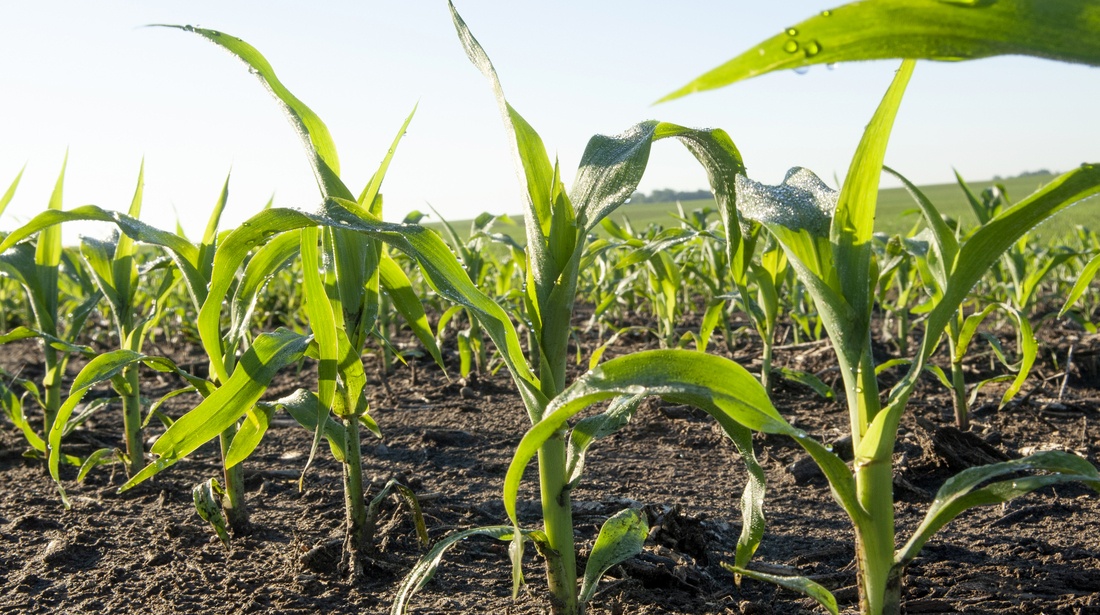According to the latest Crop Progress Report, 93% of corn has emerged, with 15% listed in excellent condition, 57% good, 23% fair, 4% poor and 1% very poor. Of the 93% of soybeans planted, 82% have emerged, with 12% in excellent condition, 58% good, 25% fair, 4% poor and 1% very poor. Nutrient management will be essential to bump crops into the good or excellent categories this growing season, with nitrogen playing the leading role, especially for corn.

In last week’s edition of Stine Weekly, Stine® Seed Company Technical Agronomist Bill Kessinger discussed nitrogen leaching due to heavy moisture this spring. Now, we dive deeper into nitrogen management in crop production and why it’s important to get ahead of nitrogen deficiency in your soils before it’s too late.
What is the role of nitrogen in crop production?
Nitrogen is the No. 1 nutrient in corn crop production. It is critical to many processes within a plant and essential for growth and reproduction. Nitrogen in crop production is crucial early in the plant’s life cycle when it is most vulnerable to issues stemming from nutrient loss.
Nitrogen is also one of the most vital components for yield as it increases the protein potential of each plant and improves overall plant health. A good nutrient plan, with nitrogen as its base, combined with increased planting populations is a great recipe for maximum yields.
“To consistently increase yields, we are increasing plant populations. Increased populations are more efficient in using nutrients, but we must adjust nutrients properly to feed that crop in accordance with our yield goals.”
Bill Kessinger, Stine® Seed Company Technical Agronomist
What causes nitrogen loss in soil?
According to experts at Iowa State University Extension and Outreach, there are two primary factors of nitrogen loss: leaching and denitrification.
“Nitrogen leaching, the process by which nitrate migrates below the root zone with soil drainage, is a critical mechanism contributing to nitrogen loss,” says Richard Roth, assistant professor and nitrogen science education specialist. “Conversely, denitrification is a biochemical reaction, catalyzed by soil bacteria in oxygen-depleted, saturated conditions, that transforms nitrate into nitrogen gas.”
The Cation exchange capacity, CEC, along with organic matter, plays a big role in holding nitrogen. The lower the CEC and lower organic matter, the fewer sites there are to hold nitrogen. Nitrogen loss will be higher in those conditions, especially under heavy rainfall. Soils can typically hold 10 pounds of nitrogen for every CEC. For example, 4.2 CEC can hold 42 pounds of nitrogen at one time.
With the heavy rainfall this spring, nitrogen applied in the fall or as a pre-plant may have washed away, forcing leaching or denitrification. Experts from Colorado State Extension note it’s estimated that about 30% of nitrogen applied to crops is lost through leaching, volatilization or denitrification. These losses are usually higher during wet years.
Growers can identify nitrogen loss in a couple of ways: through regular crop scouting or an in-season soil test.
“Don’t be fooled by the color of green of the plant. Depending on characteristics of the plant, some corn hybrids will be dark green, while others will have a lighter hue.”
Bill Kessinger, Stine® Seed Company Technical Agronomist
When corn is deficient in nitrogen, the lower leaves will show first because nitrogen is mobile and will move up the plant. The lower leaves will have an inversed triangle down the center of the leaf starting at the tip. That triangle will be yellow to brown depending on the amount and timing of deficiency.
If appearance and growth issues are noted in a field, university extension experts and Stine agronomists can help determine next steps. Once you know how much nitrogen was lost, there are tools, like the Corn Nitrogen Rate Calculator or the University of Nebraska-Lincoln’s Maize-N, to calculate what you need to put back on your fields.
How do farmers manage nitrogen levels in soil?
Nitrogen can be applied through a handful of different fertilizer applications. Fertilizers that contain nitrogen include urea, anhydrous ammonia, ammonia sulfate and liquid nitrogen. Each form has different application, use rate and timing recommendations, so it’s important to follow directions to ensure they are properly applied and can convert to nitrogen in the soil when the plant needs it most.
There are many great resources available that have different nitrogen sources, applications and timelines for conversion, including from Iowa State University Extension and Outreach and the University of Minnesota Extension. A university extension department near you may be able to provide more localized guidance.
For applications, Kessinger says you must split apply nitrogen.
“With the past wet conditions and above-normal nitrogen loss, you need to come in with your side-dress earlier than you’ve done in the past,” notes Kessinger.
It’s also important to remember sulfur when applying a side-dress of nitrogen. Sulfur helps plants metabolize and stabilize nitrogen.
“It takes groceries to feed your crop,” says Kessinger. “Without sulfur, it becomes increasingly difficult to achieve top-end yields. Timely sulfur applications work in tandem with nitrogen and need to be part of your management approach now and in the future.”
If you have a crop where nitrogen or other nutrient loss is a concern, contact your local sales rep or regional sales agronomist to discuss next steps.
Related Articles
-

Use Stine’s XP® seed treatments to prevent early injury to your crops
December 2025 in Agronomy
-

Understanding Stine’s enhanced oil profile soybeans
December 2025 in Agronomy
-

Soil sampling sets the stage for spring
November 2025 in Agronomy
-

Corn production growth paves way for more high-performing Stine® hybrids
November 2025 in Agronomy



